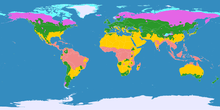Geographical zone

The five main latitude regions of the Earth's surface comprise geographical zones, divided by the major circles of latitude. The differences between them relate to climate. They are as follows:
- The North Frigid Zone, between the Arctic Circle 66.5 degrees north and the North Pole 90 degrees north. Covers 4.12% of Earth's surface
- The North Temperate Zone, between the Tropic of Cancer 23.5 degrees north and the Arctic Circle 66.5 degrees north. Covers 25.99% of Earth's surface
- The Torrid Zone, between the Tropic of Cancer 23.5 degrees north and the Tropic of Capricorn 23.5 degrees south. Covers 39.78% of Earth's surface
- The South Temperate Zone, between the Tropic of Capricorn 23.5 degrees south and the Antarctic Circle 66.5 degrees south. Covers 25.99% of Earth's surface
- The South Frigid Zone, from Antarctic Circle 66.5 degrees south and the South Pole 90 degrees south. Covers 4.12% of Earth's surface.

On the basis of latitudinal extent The globe is divided into three board heat zones. They are as follows
Torrid Zone
The Torrid or Tropical Zone is also known as the Tropics. The zone is bounded on the north by the Tropic of Cancer and on the south by the Tropic of Capricorn; these latitudes mark the northern and southern extremes of regions in which the sun seasonally passes directly overhead. At those two latitudes this happens once a year, but in the region between them the sun passes overhead twice a year:
In the Northern Hemisphere, in the sun's apparent northward migration after the March equinox, it passes overhead once, then after the June solstice, at which time it reaches the Tropic of Cancer, it passes over again on its apparent southward journey. After the September equinox the sun passes into the Southern Hemisphere. It then passes similarly over the southern tropical regions until it reaches the Tropic of Capricorn at the December solstice, and back again as it returns northwards to the Equator.
Temperate Zones
In the two Temperate Zones, consisting of the tepid latitudes, the Sun is never directly overhead, and the climate is mild, generally ranging from warm to cool. The four annual seasons, spring, summer, autumn and winter, occur in these areas. The North Temperate Zone includes Europe, Northern Asia, and North and Central America. The South Temperate Zone includes Southern Australasia, southern South America, and Southern Africa.
Frigid Zones
The two Frigid Zones, or polar regions, experience the midnight sun and the polar night for part of the year - at the edge of the zone there is one day at the winter when the Sun is invisible, and one day at the summer solstice when the sun remains above the horizon for 24 hours, while in the center of the zone (the pole), the day is literally one year long, with six months of daylight and six months of night. The Frigid Zones are the coldest parts of the earth, and is generally covered with ice and snow.
History
The idea of a geographical zone was first hypothesized by the ancient Greek scholar Parmenides[1] and lastingly modified by Aristotle.[2] Both said that the earth was divided into three types of climatic zones, based on their distance from the equator.
Like Parmeneides, thinking that the area near the equator was too hot for habitation, Aristotle dubbed the region around the equator (from 23.5° N to 23.5° S) the "Torrid Zone." Both reasoned that from the Arctic Circle to the pole was permanently frozen. This uninhabitable zone was called the "Frigid Zone." The only area believed to be habitable was the northern "Temperate Zone" (the southern one not having been discovered), lying between the "Frigid Zones" and the "Torrid Zone". However, humans have inhabited almost all climates on Earth, including inside the Arctic Circle.
As knowledge of the Earth's geography improved, a second "Temperate Zone" was discovered south of the equator, and a second "Frigid Zone" was discovered around the Antarctic. Aristotle's map was vastly oversimplistic, although the general idea was correct. Today, the most commonly used climate map is the Köppen climate classification, developed by Russian climatologist of German descent and amateur botanist Wladimir Köppen (1846–1940), which divides the world into five major climate regions, based on average annual precipitation, average monthly precipitation, and average monthly temperature.
.svg.png)
See also
References
- ↑ Strab. 2,2,1-2 in: A. H. Coxon and R. D. McKirahan (eds), The Fragments of Parmenides: A Critical Text With Introduction, and Translation, the Ancient Testimonia and a Commentary, 2nd edn (Phronesis: Supplementary Volumes 3; Assen, Dover (NH), 2009), p. 160.
- ↑ Aristotle, Meteorology, Bekker numbers 362a33-362b29